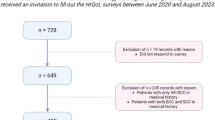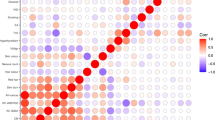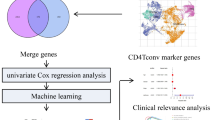Abstract
Gorlin syndrome is an autosomal dominant disorder, characterized by multiple early-onset basal cell carcinomas (BCCs) and jaw keratocysts. Through association studies in cohorts of sporadic BCC, nine genetic variants have previously been identified to increase the risk of BCC. The nine SNPs were genotyped by Taqman allelic discrimination in 125 individuals with Gorlin syndrome. Kaplan–Meier survival curves and Cox proportional-Hazard regression analysis were applied to determine the association between genotypes and age of first BCC in individuals with Gorlin syndrome. The p.(Arg151Cys) variant in MC1R (rs1805007) was associated with an earlier median age of onset of BCC of 27 years (95% CI: 20–34) compared with 34 years (95% CI: 30–40) for wild-type individuals (hazard ratio (HR)=1.64, 95% CI: 1.04–2.58, P=0.034). The risk allele of the variant at the chromosome 5p15 locus encompassing TERT-CLPTM1L (rs401681) was also associated with an earlier median onset of BCC, 31 years (95% CI: 28–37) compared with 41 years (95% CI: 32–48, HR=1.44, 95% CI: 1.08–1.93, P=0.014). In individuals with a risk allele at either rs1805007 or rs401681 the median time to BCC was 31 years of age (95% CI: 28–34) compared with 44 years of age (95% CI: 38–53) in wild-type individuals (HR=2.48, 95% CI: 1.47–4.17, P=0.0002). Our findings may have implications for future personalized risk estimates and BCC screening strategies in individuals with Gorlin syndrome.
Similar content being viewed by others
Log in or create a free account to read this content
Gain free access to this article, as well as selected content from this journal and more on nature.com
or
References
Evans DG, Farndon PA : Nevoid basal cell carcinoma syndrome; 2002 Jun 20 [updated 2011 Nov 3] In: Pagon RA, Bird TD, Dolan CR eds. GeneReviews [Internet]. University of Washington, Seattle: Seattle, WA, 1993.
Evans DGR, Ladusans EJ, Rimmer S, Burnell LD, Thakker N, Farndon PA : Complications of the naevoid basal cell carcinoma syndrome: results of a population based study. J Med Genet 1993; 30: 460–464.
Kimonis VE, Goldstein AM, Pastakia B et al: Clinical manifestations in 105 persons with nevoid basal cell carcinoma syndrome. Am J Med Genet 1997; 69: 299–308.
Jones EA, Sajid MI, Shenton A, Evans DG : Basal cell carcinomas in Gorlin Syndrome: a review of 202 patients. J Skin Cancer 2011; 2011: 217378.
Evans DG, Howard E, Giblin C et al: Birth incidence and prevalence of tumor-prone syndromes: estimates from a UK family genetic register service. Am J Med Genet 2010; 152A: 327–332.
Gorlin RJ : Nevoid basal cell carcinoma (Gorlin) syndrome. Genet Med 2004; 6: 530–539.
Tom WL, Hurley MY, Oliver DS, Shah MR, Bree AF : Features of basal cell carcinomas in basal cell nevus syndrome. Am J Med Genet 2011; 155A: 2098–2104.
Hahn H, Wicking C, Zaphiropoulos PG et al: Mutations of the human homolog of Drosophila patched in the nevoid basal cell carcinoma syndrome. Cell 1996; 85: 841–851.
Bale AE, Yu KP : The hedgehog pathway and basal cell carcinomas. Hum Mol Genet 2001; 10: 757–762.
Epstein EH : Basal cell carcinomas: attack of the hedgehog. Nat Rev Cancer 2008; 8: 743–754.
Zhang H, Ping XL, Lee PK et al: Role of PTCH and p53 genes in early-onset basal cell carcinoma. Am J Pathol 2001; 158: 381–385.
Scherer D, Bermejo JL, Rudnai P et al: MC1R variants associated susceptibility to basal cell carcinoma of skin: interaction with host factors and XRCC3 polymorphism. Int J Cancer 2008; 122: 1787–1793.
Nan H, Xu M, Kraft P et al: Genome-wide association study identifies novel alleles associated with risk of cutaneous basal cell carcinoma and squamous cell carcinoma. Hum Mol Genet 2011; 20: 3718–3724.
Stacey SN, Gudbjartsson DF, Sulem P et al: Common variants on 1p36 and 1q42 are associated with cutaneous basal cell carcinoma but not with melanoma or pigmentation traits. Nat Genet 2008; 40: 1313–1318.
Stacey SN, Sulem P, Masson G et al: New common variants affecting susceptibility to basal cell carcinoma. Nat Genet 2009; 41: 909–914.
Levanat S, Mubrin MK, Crnić I, Situm M, Basta-Juzbasić A : Variable expression of Gorlin syndrome may reflect complexity of the signalling pathway. Pflugers Arch 2000; 439: R31–R33.
Kiiski V, de Vries E, Flohil SC et al: Risk factors for single and multiple basal cell carcinomas. Arch Dermatol 2010; 146: 848–855.
Rafnar T, Sulem P, Stacey SN et al: Sequence variants at the TERT-CLPTM1L locus associate with many cancer types. Nat Genet 2009; 41: 221–227.
Antoniou AC, Beesley J, McGuffog L et al: Common breast cancer susceptibility alleles and the risk of breast cancer for BRCA1 and BRCA2 mutation carriers: implications for risk prediction. Cancer Res 2010; 70: 9742–9754.
Barnes DR, Antoniou AC : Unravelling modifiers of breast and ovarian cancer risk for BRCA1 and BRCA2 mutation carriers: update on genetic modifiers. J Intern Med 2012; 271: 331–343.
Acknowledgements
This work was supported by the British Skin Foundation and Manchester Biomedical Research Centre. DGE is a NIHR Senior Investigator.
Author information
Authors and Affiliations
Corresponding author
Ethics declarations
Competing interests
The authors declare no conflict of interest.
Additional information
Supplementary Information accompanies this paper on European Journal of Human Genetics website
Supplementary information
Rights and permissions
About this article
Cite this article
Yasar, B., Byers, H., Smith, M. et al. Common variants modify the age of onset for basal cell carcinomas in Gorlin syndrome. Eur J Hum Genet 23, 708–710 (2015). https://doi.org/10.1038/ejhg.2014.167
Received:
Revised:
Accepted:
Published:
Issue date:
DOI: https://doi.org/10.1038/ejhg.2014.167
This article is cited by
-
Genodermatoses – Opportunities for Early Detection and Cancer Prevention
Current Genetic Medicine Reports (2022)
-
Current recommendations for cancer surveillance in Gorlin syndrome: a report from the SIOPE host genome working group (SIOPE HGWG)
Familial Cancer (2021)
-
Mutiple keratocystic odontogenic tumors (KCOT) in a patient with Gorlin syndrome: a case report with late presentation and absence of skin manifestations
BMC Research Notes (2016)



